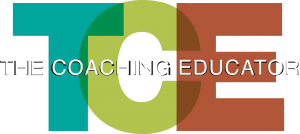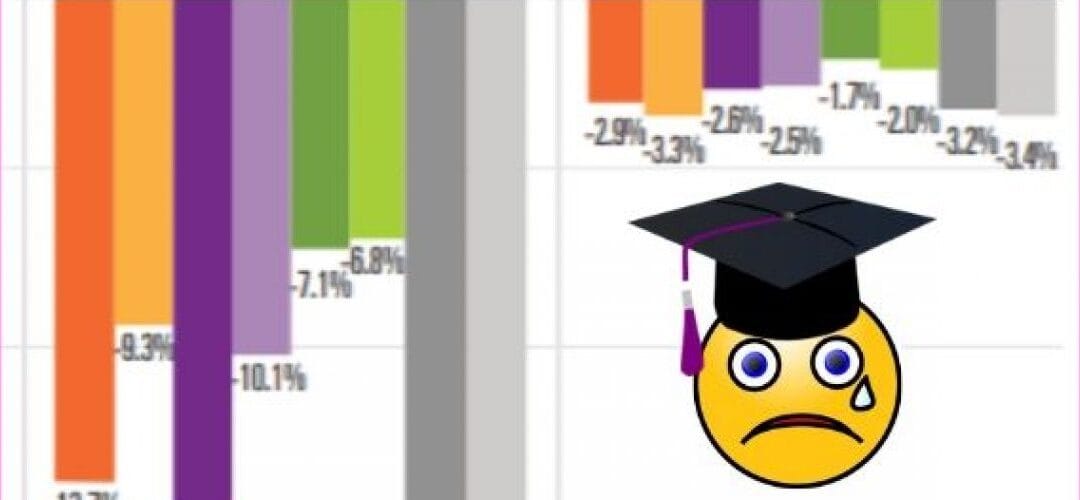By Paul Culp, MA (Oxon.), CFT, GCDF, CCSP
For obvious reasons, the majority of our articles deal with the persistently skyrocketing cost of college. A few days ago, we considered whether trade school might be a viable means of preparing for a lucrative career without incurring enormous financial obligations. (Not surprisingly, we discovered pros and cons. You’ll need to read Trade School or College? What to Consider to find out what we found out.) Whether because of preemptive costs or loss of faith in the advantages of college, or some other reason perhaps related to cultural change, fewer and fewer people are choosing it. According to a report issued last week by the National Student Clearinghouse Research Center and taking into account 97 percent of Title IV degree-granting institutions, college enrollment in the U.S. has declined steadily since the fall of 2015.
This actually represents the continuation of a decade-old trend that followed a long period of explosive growth in the higher-education sector. According to the National Council for Education Statistics, “Fall enrollment in degree-granting post-secondary institutions increased 23 percent between 1995 and 2005. Between 2005 and 2015, enrollment in degree-granting post-secondary institutions increased 14 percent, from 17.5 million to 20.0 million. The overall increase between 2005 and 2015 reflects an increase of 20 percent between 2005 and 2010, followed by a decrease of 5 percent between 2010 and 2015.”
Bye-bye, boom. Bon jour, bust.
According to the NSCRC, enrollment this spring is 1.7 percent lower than at the same time last year, an amount equal to approximately 300,000 students. Last year’s decline in college enrollment was 1.8 percent. Current enrollment is about 17.5 million, right in line with fourteen years ago. Four-year public institutions account for 7.6 million, with public two-year schools adding 5 million to the public sector. Private non-profits account for 3.8 million and for-profits another 744,000.
The bigger the school, the bleaker the news. Institutions enrolling fewer than 3,000 students, and private colleges in the 3,000-to-9,999 range, witnessed a contraction of .8 percent. Institutions enrolling 10,000 or more registered an 8 percent reduction.
Four-year public institutions, which had resisted the trend in 2015 and 2016 and posted small gains, have seen consistent declines since 2017. What of the commonplace assertion that “people are going to community college instead”? Like so many commonplace assertions, it turns out generally to be hogwash, local variations and anecdotal evidence notwithstanding. Two-year public institutions nationwide have seen enrollment fall at nearly twice the rate prevailing among their four-year brethren. The public sector overall witnessed a drop-off of nearly 2 percent from last year.
The private sector is another story. While four-year not-for-profits had previously tended toward minor declines, their enrollment is up 3.2 percent over the same time a year ago, after posting a 2.4 percent rise autumn-to-autumn in 2017-18. However, the NSCRC explains that this is largely due to the conversion of for-profit colleges to non-profit status. For-profits have been taking a steady beating over the last four years, with an enrollment swoon of just under 20 percent from last spring to this.
Among types of degrees sought, associate’s degrees were those most in retreat, followed by bachelor’s and graduate degrees.
Looking good? Eating well? Becoming wise? Finding an e-wizard? Maybe not in your future.
The sharpest decline among subject areas was in personal and culinary services, at 16.7 percent. The liberal arts were down 7.1 percent. Health professions in junior college ranks saw a fall-off of 11 percent. Computer science, once the Holy Grail, took a 5.4 percent hit across all institution types. Mechanical and repair technology is down 6 percent.
Across higher education as a whole, male students dropped out at a greater rate than females, 2.8 percent to .8 percent.
Some readers of the study have suggested that the decline in college enrollment has occurred because Americans are having fewer children, but the numbers do not bear this out for the period in which today’s collegians were born. According to the National Council for Education Statistics, “The 18- to 24-year-old population, or the traditional college-age population, increased from 27.3 million in 2000 to 30.6 million in 2017.”
The change in the racial-ethnic makeup of that population is worthy of attention but not revolutionary: Whites as a percentage of the college-age population decreased from 62 to 54 percent while Hispanics increased from 18 percent to 22 percent, but the black college-age population held steady at 14 percent as the Asian cohort increased from 4 to 6 percent and the two-or-more-races group from 2 to 4 percent.
The radical decline in college enrollment isn’t here yet…
However, Econofact points out that the U.S. population as a whole has been shifting toward the South and West, “away from higher education’s traditional markets.” Recent birth rates also do not bode well for higher education: Statista reports that the overall rate fell from 14.3 percent per thousand people in 2007 to 11.8 percent in 2017 and that there is an inverse relationship between income and birth rate.
There can be little question that demographics will impose a painful restructuring on higher education in the near future, but we believe the decline in college enrollment up to this point has been largely the product of escalating costs. As we noted in An Arm and a Leg and Your First-born Child: Why College Costs so Much, the cost of college rose 1,120 percent between 1978 and 2012—nearly double the price increase of medical care and five times the price of food—and it has kept on going. Student debt per borrower averages $37,000, and more than 2 million debtors are in six figures. An increasing number of students and their families simply are unwilling to place themselves under such oppressive long-term burdens.
We at The Coaching Educator are in business not only to help students determine which colleges are right for them and to help them navigate the admissions process, but also to help them find the means of minimizing the cost of college. Last year our clients saw an average return of 25:1 on their investment in our services, and we’ve seen as high as an 89-fold ROI. We also feel good about our Neighbor Scholars program: When you register for one of our guidance programs, we donate another registration for a family that qualifies for need-based sponsorship.
The Coaching Educator is doing well by doing good. To learn more about our philosophy and capabilities, be sure to watch our free webinars, listen to our podcasts, sign up for our four-week College App Boot Camp, consider our Ultimate Programs and our special services for athletes and performing-arts students, and book a consultation to hear what we can do for you and how we do it. Keep reading this blog, and look for us on social media (see links below) as we keep our clients and admirers advised of new developments in our effort to help students get into and succeed at the right school.
Paul Culp is certified as a global career development facilitator and writes about college admissions, college costs, financial aid, and college life in general for The Coaching Educator team. A former journalist and corporate ghostwriter who now operates Shenandoah Proofreading, Editing & Composition Services (SPECS), he has also been a humanities teacher at all levels from university down to sixth grade. Paul has degrees from Oxford University, Jacksonville State University, and Samford University, and also is certified as a fitness trainer.
Image credit: Bar chart by National Student Clearinghouse Research Center
We hope you enjoyed “Decline in College Enrollment Continues.” We also recommend:
Culp, Paul. “An Arm and a Leg and Your First-born Child: Why College Costs So Much, The Coaching Educator, http://tce.local/2018/09/06/an-arm-and-a-leg-and-your-first-born-child-why-college-costs-so-much/
Culp, Paul. “Beyond Tuition, Fees, and Books: The Other Costs of College,” The Coaching Educator, 7 June 2018, http://tce.local/2018/06/07/beyond-tuition-fees-and-books-the-other-costs-of-college/
Culp, Paul. “Eat Your Alphabet Soup: FAFSA, EFC, COA, and Other Delights,” The Coaching Educator, http://tce.local/2018/11/06/eat-your-alphabet-soup-fafsa-efc-coa-and-other-delights/
Culp, Paul. “‘Free College’ Wouldn’t Be Free. Is it Coming Anyway?” The Coaching Educator, 27 March 2019, http://tce.local/2019/03/27/free-college-wouldnt-be-free-is-it-coming-anyway/
Culp, Paul. “The Rise of Artificial Intelligence and the Need for Liberal Arts Education,” The Coaching Educator, http://tce.local/2018/06/07/the-rise-of-artificial-intelligence-and-the-need-for-liberal-arts-education/
Culp, Paul. “Sustained: The Surplus of Law School Graduates,” The Coaching Educator, 14 May 2019, http://tce.local/2019/05/14/sustained-the-surplus-of-law-school-graduates/
Culp, Paul. “3D Printing WILL Change Your Life—But How?” The Coaching Educator, 28 May 2019, http://tce.local/2019/05/28/3d-printing-will-change-your-life-but-how/
Culp, Paul. “Trade School or College? What to Consider,” The Coaching Educator, 29 May 2019, http://tce.local/2019/05/29/trade-school-or-college-what-to-consider/
Culp, Paul. “Types of Financial Aid: A Very Short Primer,” The Coaching Educator, 14 September 2018, http://tce.local/2018/09/14/types-of-financial-aid-a-very-short-primer/

